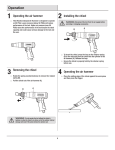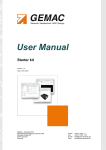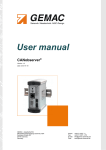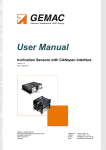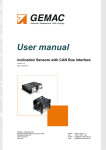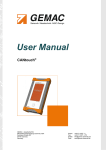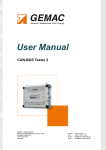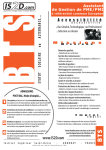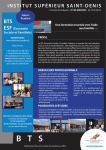Download User manual Inclination Sensors with Current and Voltage Interface
Transcript
User manual Inclination Sensors with Current and Voltage Interface Version: 1.2 Date: 2012-05-31 GEMAC - Gesellschaft für Mikroelektronikanwendung Chemnitz mbH Zwickauer Straße 227 09116 Chemnitz Germany Phone: Fax: E-mail: Web: +49 371 3377 - 0 +49 371 3377 - 272 [email protected] www.gemac-chemnitz.de Revision History Revision History Date Revision Changes 2010-09-14 0 preliminary 2011-07-01 1 first version 2012-05-31 2 various changes, critical damped digital filter added © Copyright 2012 GEMAC - Gesellschaft für Mikroelektronikanwendung Chemnitz mbH This document is subject to change without notice. We constantly work to further develop of our products. We reserve any changes of the scope of delivery in shape, equipment and technology for ourselves. No claims can be made from the details, illustrations and descriptions in this document. Any kind of duplication, reprocessing and translation of this document as well as excerpts from it require the written permission of GEMAC mbH. All rights according to the copyright remain explicitly reserved for GEMAC mbH. Document: 23xxx-HB-1-2-E-ISxDxxP2425 I Table of Contents Table of Contents 1 Overview...................................................................................................................................................... 1 1.1 Characteristics..................................................................................................................................... 1 1.2 Applications.......................................................................................................................................... 1 2 Technical Data............................................................................................................................................. 2 3 Mounting...................................................................................................................................................... 4 3.1 Position of Drilling Holes...................................................................................................................... 4 3.2 Definition of the Axes........................................................................................................................... 4 4 Connection................................................................................................................................................... 5 4.1 Connector Pin Out............................................................................................................................... 5 4.2 Connection diagram............................................................................................................................. 5 4.3 Cable length and minimum supply voltage for current interface...........................................................6 5 Functional description.................................................................................................................................. 7 5.1 Axis assignment / Axis direction........................................................................................................... 7 5.2 Zero Point Adjustment.......................................................................................................................... 7 5.3 Digital Filter.......................................................................................................................................... 7 5.4 Status LED........................................................................................................................................... 8 6 Sensor configuration.................................................................................................................................... 9 6.1 Inclination sensor programming adapter..............................................................................................9 6.2 PC software ISDControl..................................................................................................................... 10 6.2.1 Configuration of all values.......................................................................................................... 10 6.2.2 3D imaging and display of the current angle..............................................................................11 6.2.3 Oscilloscope display of the current angle...................................................................................12 7 Ordering Information.................................................................................................................................. 13 Document: 23xxx-HB-1-2-E-ISxDxxP2425 II List of Tables List of Tables Table 1: Technical Data................................................................................................................................... 2 Table 2: Electromagnetic Compatibility (EMC)................................................................................................ 3 Table 3: Cable length at minimum supply voltage and different wires sizes...................................................6 Table 4: Filter selection................................................................................................................................... 7 Table 5: Status and Error Display through Status LED....................................................................................8 Table 6: Ordering Information....................................................................................................................... 13 Document: 23xxx-HB-1-2-E-ISxDxxP2425 III List of Figures List of Figures Figure 1: Dimensioned Sketch of plastic housing........................................................................................... 4 Figure 2: Definition of the Axes (factory default settings)................................................................................4 Figure 3: Connector Pin Out........................................................................................................................... 5 Figure 4: Connection diagram: current interface.............................................................................................5 Figure 5: Connection diagram: voltage interface............................................................................................. 5 Figure 6: Cable length at current interface...................................................................................................... 6 Figure 7: Impulse and amplitude response of the two filters...........................................................................7 Figure 8: Starter kit......................................................................................................................................... 9 Figure 9: Numerical configuration of the inclination sensor...........................................................................10 Figure 10: Graphical configuration of the outputs A and B.............................................................................11 Figure 11: 3D imaging and display of the current angle.................................................................................11 Figure 12: Oscilloscope display of the current angle.....................................................................................12 Document: 23xxx-HB-1-2-E-ISxDxxP2425 IV 1 Overview 1 Overview 1.1 Characteristics Inclination sensors with measurement range: 360° / ±90° (X/Y) Linearized output, high accuracy (0.06°) Compensated cross sensitivity Programmable vibration suppression Freely programmable current or voltage interface Robust, UV resistant, impact strength plastic housing Suitable for industrial use: Temperature range: -40 °C to +80 °C Degree of protection: IP65/67 The 1-dimensional inclination sensors IS1D 00 P24 and IS1D 00 P25 are suitable to measure the inclination in the measurement range of 360°, the 2-dimensional inclination sensors IS2D 90 P24 and IS2D 90 P25 is suitable to measure the inclination in 2 dimensions (X/Y) of ±90°. To ensure a high accuracy, the sensors are calibrated at the factory. The compact and robust design makes the sensor a suitable angle measurement device in rough surround ings for different applications in industry and vehicle technology. 1.2 Applications Solar thermal and photo-voltaic systems Agricultural and forestry machinery Construction machinery Crane and hoisting technology Document: 23xxx-HB-1-2-E-ISxDxxP2425 1 2 Technical Data 2 Technical Data General Parameters1 Measurement range 360°, ±90° Resolution 0.01° Accuracy (Type: IS1D 00 P24/25) Range 0...360° typical ±0.04° maximum ±0.12° Accuracy (Type: IS2D 90 P24/25) Range up to ±60° up to ±70° up to ±80° up to ±85° typical ±0.02° ±0.04° ±0.08° ±0.16° maximum ±0.06° ±0.12° ±0.24° ±0.48° Cross Sensitivity2 (compensated) typ. ±0.10 %, max. ±0.50 % Temperature coefficient (zero point) Current interface: Voltage interface: Sampling rate 100 Hz Cut-off frequency typ. 20 Hz, 2nd order (without digital filter) / 0.1 ... 25 Hz, 8th order (with digital filter) Operating temperature -40 °C to +80 °C typ. +0,0088 °/K, -0,0102 °/K typ. ±0,0083 °/K Characteristics Current interface freely adjustable output in the range 0...20.48 mA (factory default: 4...20 mA) freely adjustable angle in the range 0...360° / ±90° Voltage interface freely adjustable output in the range -10.48...10.48 V (factory default: 0...10 V) freely adjustable angle in the range 0...360° / ±90° Funktionen Teach input for zero point adjustment when installed Limit value , Axis direction and assignment of the outputs are adjustable Digital filter (Butterworth lowpass, 8th order) Electrical Parameters Supply voltage Current interface: Voltage interface: 17 to 35 VDC 10 to 35 VDC Current consumption Current interface: Voltage interface: 45 mA @ 24 V + Iloop 45 mA @ 24 V Outputs (short-circuit proof) Current interface: Voltage interface: inductive load less than 1 H, load 500 Ω (default) capacitive load less than 1,2 μF, resistive load greater than 2 kΩ Mechanical Parameters Connection Sensor connector 5-pole M12 Degree of protection IP65/67 Dimensions / Weight 66 mm x 90 mm x 36 mm / about 200 g CE conformity to EC Directive 2006/42/EC EC Directives RL 2004/108/EC EMC Directive RL 2006/95/EC Low Voltage Directive (LVD) Harmonized standards DIN EN 50498:2010 Electromagnetic compatibility (EMC) - Product family standard for aftermarket electronic equipment in vehicles EN 60950-1:2006/A1:2010 Information technology equipment. Safety. General requirements EN ISO 14982:2009 Agricultural and forestry machinery. Electromagnetic compatibility. Test methods and ac ceptance criteria DIN EN 13309:2010 Construction machinery - Electromagnetic compatibility of machines with internal power supply Table 1: Technical Data 1 All indicated angle accuracies are valid after a running time of 10 minutes at 25 °C, Cut-off frequency 0.3 Hz Absolute calibration accuracy (at 25 °C): ±0.05° 2 type only: IS2D 90 P24/25 Document: 23xxx-HB-1-2-E-ISxDxxP2425 2 2 Technical Data Electromagnetic Compatibility (EMC) Transient Emissions Radiated disturbance / Radio field strength Limit curves broadband and narrowband EN ISO 14982 (agricultural and forestry machinery) respectively EN ISO 13309 (construction machinery) 30 ... 1000 MHz (vertical and horizontal) Immunity to Radio Frequency Fields (RF fields) Strip line according to ISO 11452-5 Limits according to EN ISO 14982 (agricultural and forestry machinery) respectively EN ISO 13309 (construction machinery) 20 ... 400 MHz 200 V/m (1 KHz AM) Performance criteria A Anechoic chamber according to ISO 11452-2 Limits according to EN ISO 14982 (agricultural and forestry machinery) respectively EN ISO 13309 (construction machinery) 200 ... 1000 MHz vertical / 400 ... 1000 MHz horizontal 100 V/m (1 KHz AM) Performance criteria A Immunity to Conducted Disturbances (on-board power supply 24 VDC) Test pulse according to ISO 7637-2:2004 Test pulse 1 -450 V 2a +37 V 2b +20 V 3a -150 V 3b +150 V 4 -12 V 5a +70 V 5b +36 V Severity level III III III III III III Ri = 1 Ω Ri = 0,5 Ω Performance criteria C B C A A B A A Immunity to Electromagnetic Discharge (ESD) ESD according to ISO 10605:2008 Limits according to EN ISO 14982 (agricultural and forestry machinery) respectively EN ISO 13309 (construction machinery) discharge combination 330 pF / 330 Ω Contact discharge 8 KV bipolar (metallic parts) Air discharge 15 KV bipolar Performance criteria A Table 2: Electromagnetic Compatibility (EMC) Document: 23xxx-HB-1-2-E-ISxDxxP2425 3 3 Mounting 3 Mounting 3.1 Position of Drilling Holes The four drilling holes to mount the sensor (Figure 1) are situated in the base plate of the inclination sensor. Figure 1: Dimensioned Sketch of plastic housing 3.2 Definition of the Axes Figure 2: Definition of the Axes (factory default settings) Document: 23xxx-HB-1-2-E-ISxDxxP2425 4 4 Connection 4 Connection 4.1 Connector Pin Out The inclination sensors IS1D 00 P24/25 and IS2D 90 P24/25 are equipped with a common 5-pole round plug M12 (A-coded). Pin Signal Allocation 1 V+ Supply voltage (+24 V) 2 B-OUT (Standard Y) Sensor output B 3 V- / GND Supply voltage ground / Sensor ground 4 A-OUT (Standard X) Sensor output A 5 TEACH Input for zero point adjustment Figure 3: Connector Pin Out 4.2 Connection diagram Figure 4: Connection diagram: current interface Figure 5: Connection diagram: voltage interface Document: 23xxx-HB-1-2-E-ISxDxxP2425 5 4 Connection 4.3 Cable length and minimum supply voltage for current interface At current interface, the required supply voltage is increased by the voltage drop on the connected cable. The highest voltage drop on the cable is produced when the maximum current of 20 mA is flowing through the resistance of the cable (RL). Here, the resistance of the outgoing and the incoming wire must be taken into account (refer to Figure 6). Figure 6: Cable length at current interface The following table shows examples of the possible cable length at minimum supply voltage and the corres ponding wire size (cross section). The table is based on the calculation of the line resistance according to VDE 0295 and a load resistance (Rload) of 500 Ω. Minimum supply voltage in V Cable resistance in Ω 17 Maximum cable length in m at at wire sizes of: 0,14 mm² 0,25 mm² 0,34 mm² 0,50 mm² 0,75 mm² 10 35 60 84 124 187 18 50 176 304 423 623 936 20 150 528 914 1271 1870 2808 22 250 880 1524 2118 3117 4681 24 350 1232 2134 2966 4364 6554 26 450 1584 2743 3813 5610 8426 28 550 1936 3353 4661 6857 10299 30 650 2288 3963 5508 8104 12172 Table 3: Cable length at minimum supply voltage and different wires sizes Document: 23xxx-HB-1-2-E-ISxDxxP2425 6 5 Functional description 5 Functional description 5.1 Axis assignment / Axis direction All inclination sensors have two analog outputs A and B that can be assigned to any in hardware available X and Y axes for the 2-dimensional inclination sensor and to the rotation axis in the 1-dimensional inclination sensor. An assignment of both outputs to the same axis is also possible. With the optional inversion of the axis direction, every conceivable constellation of the output assignment is possible. The axis direction can be changed by swapping the upper and lower current or voltage output values. 5.2 Zero Point Adjustment For all inclination sensors, the zero point can be adjusted. This allows to set the zero position in the installed state of the sensor. This can either be made via the PC program or by means of the teach input. To set the zero point using the teaching input, it must be connected for a period of at least one second with the supply voltage (V+, pin 1). The current position of the inclination sensor is then set for each output to zero degree angle. The sensor will confirm this by turning off the Status LED for the duration of one second. To reset the zero point to factory defaults, the teaching input has to be connected for the duration of three additional seconds to the supply voltage. The sensor will indicate this by turning off the Status LED for also three seconds. 5.3 Digital Filter The inclination sensor offers the possibility to suppress the influence of external disturbing vibrations. The internal lowpass digital filters (8th order) are programmable down to 0.1 Hz. The sensor has two digital fil ters that can be selected according to the application of the sensor. Filter Adjustable frequency range Applications Butterworth 0,1 Hz ... 25 Hz Static inclination measurement with high damping to vibration Critical damped 0,1 Hz ... 8 Hz Inclination measurement in applications that requires a certain dynamism, without over shoot at angle changes with good damping Table 4: Filter selection Step response 8th order filter Gain response 8th order filter 15 10 0 -10 -20 Tilt [°] Gain [dB] 10 5 -30 -40 -50 Step Butterworth, fc = 2 Hz -60 Butterworth, fc = 0.5 Hz Butterworth, fc = 0.5 Hz critically damped, fc = 2 Hz -70 0 1 2 3 4 5 Time [s] 6 7 8 9 10 critically damped, fc = 2 Hz critically damped, fc = 0.5 Hz critically damped, fc = 0.5 Hz 0 Butterworth, fc = 2 Hz -80 0.01 0.1 1 Frequency [Hz] 10 100 Figure 7: Impulse and amplitude response of the two filters Document: 23xxx-HB-1-2-E-ISxDxxP2425 7 5 Functional description 5.4 Status LED The integrated two-color Status LED signals the recent device state. The color of the LED distinguish the different device states as shown in Table 5. Status LED Description Off No power supply or teach confirmation Green The device is in working condition Red Current interface: Voltage interface: one or both outputs in open circuit condition or wrong connected one or both outputs in short circuit condition or wrong connected Table 5: Status and Error Display through Status LED Document: 23xxx-HB-1-2-E-ISxDxxP2425 8 6 Sensor configuration 6 Sensor configuration 6.1 Inclination sensor programming adapter With the optional inclination sensor programming adapter (starter kit) it is possible to adjust all inclination sensors with CAN/CANopen, current or voltage interface. It consists of a programming adapter that is con nected via USB to a PC. The connection with the programming adapter is realized through various, also in cluded adapter cables. The inclination sensor is supplied with power through this. An additional power sup ply is not necessary. Figure 8: Starter kit Document: 23xxx-HB-1-2-E-ISxDxxP2425 9 6 Sensor configuration 6.2 PC software ISDControl The parametrization of all possible values is done with the PC software ISDControl, which is included in all starter kits. Each configuration can then be stored in a file. 6.2.1 Configuration of all values For all inclination sensors, the adjustment of the parameters can be done either numerically or graphically. (refer to Figure 9 and 10). Figure 9: Numerical configuration of the inclination sensor Document: 23xxx-HB-1-2-E-ISxDxxP2425 10 6 Sensor configuration Figure 10: Graphical configuration of the outputs A and B 6.2.2 3D imaging and display of the current angle By the program integrated 3D view, the position of the sensor in space can be visualized. Figure 11: 3D imaging and display of the current angle Document: 23xxx-HB-1-2-E-ISxDxxP2425 11 6 Sensor configuration 6.2.3 Oscilloscope display of the current angle In the oscilloscope display, the influence of the adjustable digital filter can be controlled directly. Time base of the view, and amplitude and offset can be set analog to the operation of an oscilloscope. Figure 12: Oscilloscope display of the current angle Document: 23xxx-HB-1-2-E-ISxDxxP2425 12 7 Ordering Information 7 Ordering Information Article Number Product Type Description/Distinction PR-23450-00 IS1D 00 P24 1-dimensional, 360°, current interface PR-23454-00 IS2D 90 P24 2-dimensional, ±90°, current interface PR-23550-00 IS1D 00 P25 1-dimensional, 360°, voltage interface PR-23554-30 IS2D 90 P25 2-dimensional, ±90°, voltage interface PR-23998-00 TA1 Teach adapter PR-23999-01 ISPA1 Inclination sensor programming adapter (Starter kit including programming adapter, cables and PC software) Table 6: Ordering Information Document: 23xxx-HB-1-2-E-ISxDxxP2425 13




















